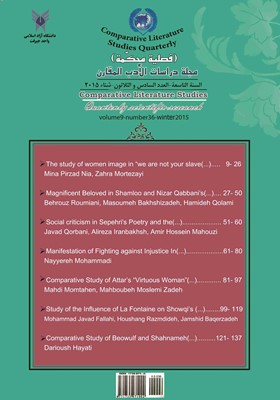-
-
List of Articles
-
Open Access Article
1 - The study of women image in “we are not your slave any longer” and “we get used to” Novels
Mina Pirzad Nia Zahra Mortezayi -
Open Access Article
2 - Magnificent Beloved in Shamloo and Nizar Qabbani's poetry
Behrouz Roumiani Masoumeh Bakhshizadeh Hamideh Qolami -
Open Access Article
3 - Social criticism in Sepehri's Poetry and the Comparison to Basic Science
Javad Qorbani Alireza Iranbakhsh Amir Hossein Mahouzi -
Open Access Article
4 - Manifestation of Fighting against Injustice In some Contemporary Authors
Nayyereh Mohammadi -
Open Access Article
5 - Comparative Study of Attar’s “Virtuous Woman” and Boccaccio’s “Thousand and One Night”
Mahboubeh Moslemi Zadeh -
Open Access Article
6 - Study of the Influence of La Fontaine on Showqi’s Fables
Mohammad Javad Fallahi Houshang Razmdideh Jamshid Baqerzadeh -
Open Access Article
7 - Comparative Study of Beowulf and Shahnameh from the Ancient Travel Point of View
Darioush Hayati
-
The rights to this website are owned by the Raimag Press Management System.
Copyright © 2021-2025







